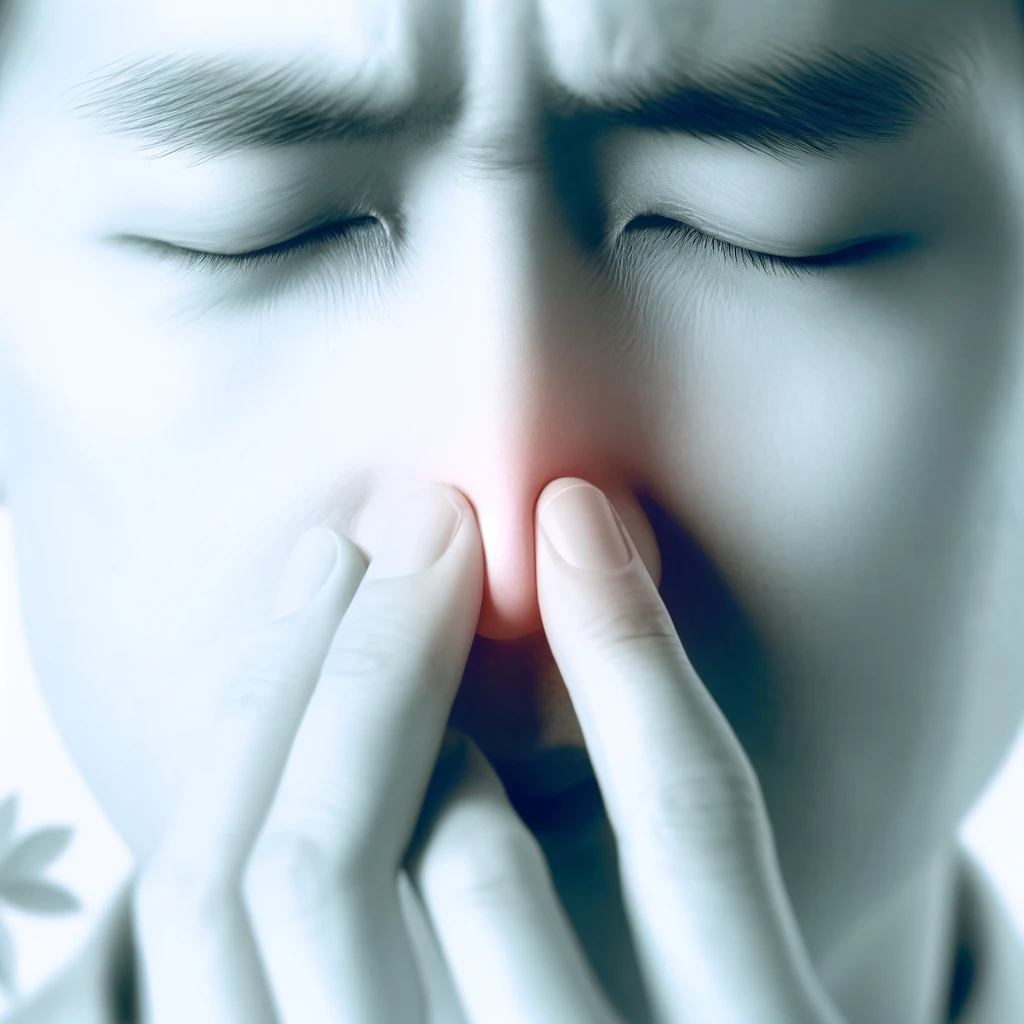Nose Pain Symptoms can be an uncomfortable and frustrating condition, affecting daily life by causing discomfort in breathing, smelling, and even eating. The nose is a delicate part of the body, and pain in this region can arise due to several reasons, ranging from minor irritations to severe medical conditions. This article will explore the causes, symptoms, and remedies for nose pain, aiming to provide comprehensive insights into the issue.

What is Nose Pain:-
Nose pain can manifest in different ways. It can be a sharp pain, a dull ache, or a constant discomfort felt inside the nasal passages, around the nostrils, or at the tip of the nose. The pain may be localized in one specific area or spread throughout the nasal structure, making it difficult to pinpoint the exact cause. In some cases, nose pain may extend to the surrounding areas, including the sinuses, forehead, or upper lip.
Common Causes of Nose Pain:-
1. Sinusitis:
Sinus infections are one of the most common causes of nose pain. Sinuses are hollow spaces in the bones around the nose, which can become inflamed or infected due to allergies, bacterial infections, or viral infections. When sinuses are blocked or swollen, pressure builds up in the nasal passages, causing pain in and around the nose.
2. Nasal Injuries:
Trauma to the nose, such as a fall, bump, or accident, can lead to nose pain. Even minor injuries, like accidentally hitting the nose or excessive nose-picking, can cause inflammation and tenderness. Severe trauma may result in fractures or displacement of nasal bones, leading to significant pain.
3. Nasal Polyps:
Nasal polyps are non-cancerous growths that form in the lining of the nasal passages or sinuses. These growths can obstruct airflow, cause congestion, and lead to discomfort or pain. Nasal polyps are usually the result of chronic inflammation, often seen in individuals with asthma, allergies, or frequent sinus infections.
4. Infections:
Various infections, such as the common cold, can cause nose pain. Viral infections lead to inflammation of the nasal tissues, causing swelling and irritation. In some cases, bacterial infections can result in more severe symptoms, including pus formation or abscesses, contributing to pain.
5. Dryness and Irritation:
Dry climates or constant exposure to air conditioning can lead to dryness inside the nose. When the nasal lining becomes dry, it can crack, causing irritation and pain. Additionally, repeated blowing of the nose or the use of harsh tissues can further damage the nasal membranes.
6. Allergic Reactions:
Allergic rhinitis, commonly known as hay fever, is caused by the body’s immune response to allergens such as pollen, dust, mold, or animal dander. This condition can cause itching, sneezing, and swelling in the nasal passages, leading to discomfort and pain.
7. Deviated Septum:
A deviated septum occurs when the thin wall (nasal septum) between the nasal passages is displaced to one side. This can cause breathing difficulties, leading to sinus problems and nose pain. In severe cases, surgery may be required to correct the deviation.
8. Nasal Tumors:
Though rare, tumors can develop in the nasal passages, leading to nose pain. Tumors may be benign or malignant and can cause nasal obstruction, bleeding, and significant discomfort. A thorough medical examination is necessary to diagnose this condition.
Nose Pain Symptoms
The symptoms that accompany nose pain vary depending on the underlying cause. Common symptoms include:
- Congestion: A blocked or stuffy nose often accompanies nose pain, particularly in cases of sinusitis or allergic reactions.
- Swelling: Inflammation in and around the nose can lead to visible swelling, especially in cases of trauma or infection.
- Headache: Sinus infections often cause headaches, particularly around the forehead and eyes, contributing to overall discomfort.
- Nasal Discharge: A runny nose with clear, yellow, or green mucus may be present, indicating infection or allergies.
- Bleeding: Trauma or dryness can cause nosebleeds, which may accompany nose pain.
- Difficulty Breathing: Obstruction of the nasal passages due to polyps, a deviated septum, or swelling can make it difficult to breathe through the nose.
- Tenderness: The nose may feel tender to the touch, particularly if there is an injury or infection.
Diagnosis and When to See a Doctor:-
Nose pain may require medical attention if it persists or is severe. If the pain is accompanied by fever, persistent bleeding, facial swelling, or vision changes, it is essential to seek medical help. A doctor may use the following diagnostic methods:
- Physical Examination: A thorough examination of the nasal passages and surrounding areas can reveal any swelling, infections, or injuries.
- Imaging Tests: X-rays or CT scans may be used to view the internal structures of the nose and sinuses, especially in cases of suspected fractures, tumors, or chronic sinusitis.
- Nasal Endoscopy: A small, flexible tube with a camera is inserted into the nasal passages to provide a detailed view of the nasal cavity and identify any abnormalities, such as polyps or tumors.
Home Remedies for Nose Pain:-
In many cases, nose pain can be managed at home with simple remedies. Here are a few methods that can provide relief:
1. Steam Inhalation:
Inhaling steam helps to open up blocked nasal passages, reduce sinus pressure, and relieve pain. You can do this by boiling water, placing a towel over your head, and inhaling the steam for a few minutes. Adding eucalyptus oil can enhance the effects.
2. Saline Nasal Spray:
Using a saline spray helps keep the nasal passages moist, reducing dryness and irritation. Saline sprays can be purchased over the counter or made at home by mixing salt and water.
3. Warm Compress:
Applying a warm compress to the nose can help reduce inflammation and relieve pain caused by sinusitis or trauma. The warmth helps improve blood circulation, which promotes healing.
4. Hydration:
Staying hydrated is essential to maintain the moisture of the nasal membranes. Drinking plenty of water helps thin mucus and reduce congestion.
5. Humidifier:
Using a humidifier in your room can prevent nasal dryness and irritation, especially in dry climates. It keeps the air moist, reducing the risk of nose pain caused by dryness.
6. Avoid Irritants:
If you are prone to allergies, avoiding known irritants such as smoke, dust, and strong odors can prevent inflammation and discomfort in the nose.
Medical Treatments for Nose Pain:-
When home remedies do not provide sufficient relief, medical treatment may be necessary. The treatment depends on the underlying cause:
- Antibiotics: If the nose pain is due to a bacterial infection, a doctor may prescribe antibiotics to clear the infection.
- Nasal Steroid Sprays: These sprays reduce inflammation and are often used to treat allergic rhinitis or nasal polyps.
- Surgery: In cases of a deviated septum, nasal tumors, or chronic sinusitis, surgery may be required to correct the issue and relieve the pain.
READ MORE- How To Fix Deviated Septum Without Surgery
Conclusion:-
Nose pain is a common problem that can result from various causes, ranging from simple irritations to more severe conditions. Understanding the underlying cause of nose pain is essential for proper treatment and relief. While home remedies can often provide relief, persistent or severe pain should be evaluated by a medical professional. By identifying the cause and using the appropriate treatment methods, you can effectively manage and alleviate nose pain, improving your overall well-being.
